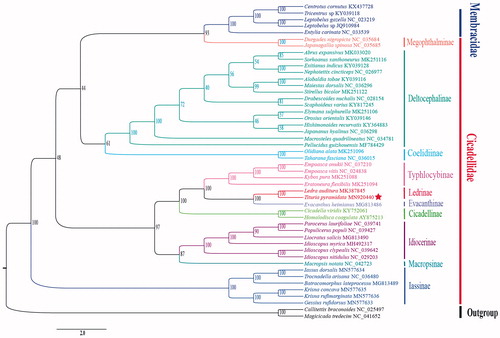Abstract
In this article, the complete mitogenome of Tituria pyramidata Cai, Citation1993 was sequenced and annotated, which contained 37 typical genes. The length of the mitochondrial genome is 15,331 bp with A + T% for the whole sequence = 75.6% (A = 29%, T = 46.6%, G = 13.7%, and C = 10.6%). Protein-coding genes (PCGs) started with standard start codon ATN (ATA, ATT, ATG, and ATC) and ended with TAR (TAA and TAG), except nad5 started with TTG, cox3 ended with single T. The phylogenetic tree confirms that T. pyramidata was clustered with Ledra auditura with strong branch support.
Tituria Stål is one of the three major genera of the subfamily Ledrinae, which is broadly distributed in Oriental and Palearctic regions (Cai Citation1993; Jones and Deitz Citation2009). At present, there are some different opinions about the systematic classification status on some species of the genus Tituria (Kuoh and Cai Citation1992; Jones and Deitz Citation2009; Zhang et al. Citation2009), and it is not convincing to classify them by morphological classification alone. Therefore, it is necessary to study them from multiple perspectives. Mitochondrial genome is widely used in evolutionary and phylogenetic studies (Cameron Citation2014). Only one complete mitochondrial genomes (mitogenomes) in Ledrinae were reported (Wang et al. Citation2019).
In order to understand the mitogenome characteristics of Tituria pyramidata, we were sequenced and annotated its mitogenomes in this study. The specimens of T. pyramidata were collected from Chungking, China (N 28°38′57.56″, E 106°24′32.65″), on 23 September 2017. The male genitalia and DNA were stored in the Institute of Entomology, Guizhou University, Guiyang, China (GUGC), with label number GZU-HCL-0030. Mitogenome sequences were assembled and annotated using Geneious Primer (Kearse et al. Citation2012) and MITOS server (Bernt et al. Citation2013).
Analysis of the mitochondrial genomes showed that the complete sequence length of the T. pyramidata is 15,331 bp (GenBank accession number MN920440), including typically 37 genes (13 protein-coding genes (PCGs), 2 ribosomal RNA genes (rRNAs), 22 transfer RNA genes (tRNAs)), and a long non-coding region (Control region). Among these genes, 23 genes are located in the majority strand, while the others are located in the minority strand, which is consistent with most insect structures. Control region is 856 bp length and located between srRNA and trn-I. The mitogenome of T. pyramidata exhibited heavy AT nucleotide bias, with A + T% for the whole sequence = 75.6% (A = 29%, T = 46.6%, G = 13.7%, and C = 10.6%). nad5 started with TGG, other PCGs started with ATN (ATA, ATT, ATG, and ATC), and all of them ended with TAR (TAA and TAG) except cox3, which ended with single T.
Based on 13 PCGs and 2 rRNAs, a phylogenetic tree was constructed for 48 species by IQ-TREE (Nguyen et al. Citation2015) (), each PCG and rRNA genes were aligned using the MAFFT algorithm in TranslatorX and MAFFT version 7.0online serve with the G-INS-i strategy, respectively, and the aligned sequences were eliminated using Gblocks version 9.1b (Abascal et al. Citation2010; Katoh et al. Citation2019). By analyzing the phylogenetic trees, the result showed that the T. pyramidata and Ledra auditura are clustered into one branch, and the Ledrinae are closely related to the Evacanthinae with high supported (bootstrap support value = 100).
Figure 1. Phylogenetic analyses of T. pyramidata based upon the concatenated nucleotides of the 13 PCGs and 2 rRNAs of 48 species by IQ-TREE. Numbers at nodes are bootstrap values. The accession number for each species is indicated after the scientific name.

In general, T. pyramidata has typical insects mitogenomes structure and characteristics, and clustered into one branch with Ledra audutura in the ML tree. This study not only enriched the mitochondrial genome data of Cicadellidae, but also contributed to the molecular verification of the monophyletic of the Ledrinae in the future.
Disclosure statement
No potential conflict of interest was reported by the author(s).
Additional information
Funding
References
- Abascal F, Zardoya R, Telford MJ. 2010. Translator X: multiple alignment of nucleotide sequences guided by amino acid translations. Nucleic Acids Res. 38(suppl_2):W7–13.
- Bernt M, Donath A, Jühling F, Externbrink F, Florentz C, Fritzsch G, Pütz J, Middendorf M, Stadler PF. 2013. MITOS: improved de novo metazoan mitochondrial genome annotation. Mol Phylogenet Evol. 69(2):313–319.
- Cai P. 1993. Five new species of the genus Tituria from China (Homoptera: Cicadelloidea: Ledridae). Acta Zool Sin. 39:41–47.
- Cameron SL. 2014. Insect mitochondrial genomics: implications for evolution and phylogeny. Annu Rev Entomol. 59(1):95–117.
- Jones JR, Deitz LL. 2009. Phylogeny and systematics of the leafhopper subfamily Ledrinae (Hemiptera: Cicadellidae). Zootaxa. 2186(1):1–120.
- Katoh K, Rozewicki J, Yamada KD. 2019. MAFFT online service: multiple sequence alignment, interactive sequence choice and visualization. Briefing Bioinform. 20(4):1160–1166.
- Kearse M, Moir R, Wilson A, Stones-Havas S, Cheung M, Sturrock S, Buxton S, Cooper A, Markowitz S, Duran C, et al. 2012. Geneious basic: an integrated and extendable desktop software platform for the organization and analysis of sequence data. Bioinformatics. 28(12):1647–1649.
- Kuoh CL, Cai P. 1992. A new species of the genus Epiclinata from China (Homoptera: Cicadelloidea: Ledridae). Acta Zool Sin. 38:136–138.
- Nguyen LT, Schmidt HA, von Haeseler A, Minh BQ. 2015. IQ-TREE: a fast and effective stochastic algorithm for estimating maximum-likelihood phylogenies. Mol Biol Evol. 32(1):268–274.
- Wang JJ, Li DF, Li H, Yang MF, Dai RH. 2019. Structural and phylogenetic implications of the complete mitochondrial genome of Ledra auditura. Sci Rep. 9(1):1–11.
- Zhang Y, Sun J, Dai W. 2009. Macrotrichia, a new genus of Ledrinae (Hemiptera: Cicadellidae) from China. Zootaxa. 2194(1):54–60.
